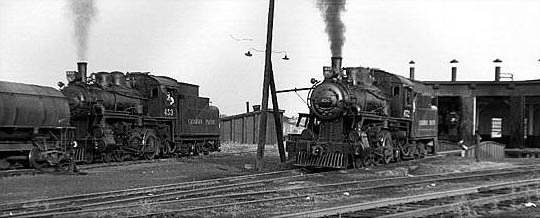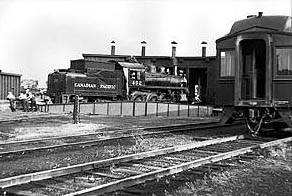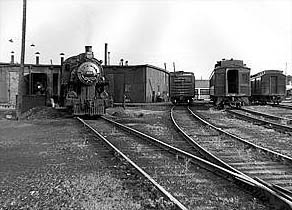
22 June 2009
Kingston's Railroad Roundhouse

Canadian Pacific 4-6-0 Ten-Wheeler
D4 class locomotives at Kingston, Ontario.
 Kingston Ontario - This is of wipers and oilers and
hostellers, firemen, and engineers. It is a story of a period that has just about vanished from all railroads around the world. Those
who wished to become steam locomotive engineers probably started their career as wipers - individuals assigned to literally wipe the
engine down and keep it looking spotless.
Kingston Ontario - This is of wipers and oilers and
hostellers, firemen, and engineers. It is a story of a period that has just about vanished from all railroads around the world. Those
who wished to become steam locomotive engineers probably started their career as wipers - individuals assigned to literally wipe the
engine down and keep it looking spotless.
If the foreman thought the neophyte was good enough, he would be promoted to oiler which allowed him to oil and grease all of the
necessary parts of the operating steam locomotive.
| |

Kingston roundhouse - July 1955 Photographer
unknown.
|
If one studied hard and took the necessary tests on both the steam engine itself and the basic operating rules of the railway, one
could progress to hostler which allowed the individual to maintain the fires in the steam engines, when they were stored in the yards
off duty. Some hostelers had the right to move the engines around the yard to station them for the next day's tasks.
To be a fireman required a strong back. Not only did they have to pay attention to water and boiler gauges, but they were also
required to shovel the coal from the tender into the engine firebox. The engines that you see in the pictures, class D4, were
considered very rough-riding locomotives and were all hand-fired. Only larger engines were built with an
automatic stoker or, in some rare cases in Canada before the 1930s, were oil fired.
| |

Kingston roundhouse - July 1955 Photographer
unknown.
|
The engineer was the "creme de la creme" of the front-end crew. He had obviously worked his way through all of
the other ranks and had managed to pass all of the necessary tests to be given his rank. In theory, the more senior engineers were
given the task of operating passenger locomotives.
Roundhouses were a particularly North American invention, not as common in the rest of the railroad world. The term signifies that the
building had a central point around which it was constructed. In particular, this is the story of a little four-stall
roundhouse which existed below the crest of the hill on Rideau Street near the water's edge at the foot of North Street on the great
Cataraqui River. Because it was beyond the end of Wellington Street, around a slight bend, and the roofline was below the level of
Rideau Street, probably, most Kingstonians didn't know of its existence.
The turntable stood in front of each roundhouse and pivoted on a central point and was designed to reverse the direction of the
engine. If the engine was balanced correctly on the turntable most could be turned with the efforts of two to six men. (See example in
picture). Larger turntables were driven by either steam or electric motors. The turntable allowed the engine to be moved into a
particular stall in the round house, the number of stalls depended upon the needs of the railroad at that location. An example of one
large roundhouse remains near the CN Tower in Toronto.
Roundhouses were essentially used for servicing and basic maintenance of steam locomotives such as the heavier oil and greasing that
needed to be done and some minor adjustments to the steam engine's running-gear. Where possible, steam engines were kept
inside, particularly in the winter months, to make it easier to keep up steam in the boilers. In larger roundhouses there was actually
a stationary steam boiler which was attached through piping to the steam engine boiler so the fire could be dropped from the
locomotive firebox. Once the steam locomotive was fired up, steam was kept up continuously in the boiler until it needed a major
inspection and pressure-test as regulated by the federal government. The heating and cooling of a boiler was considered
something to be avoided as the expansion and contraction of the boiler tubes weakened all of the joints and seals. Each time the fire
was drawn and the boiler cooled was considered to be equivalent to one month's continuous steaming.
The photographs of the Canadian Pacific Railway trains (CPR took over the Kingston & Pembroke Railway in 1913) at Kingston are
dated July 1955. It is interesting to note that all four stalls of the round house were in use and that there was enough business for
the K&P subdivision in the Kingston area (mainly the waterfront) to require the services of four small 4-6-0
Ten-Wheelers. Within ten years, all of the engines shown in this picture would be scrapped and the CP would begin using
diesels for local operation. By the l970s, the closure of the locomotive works, the Kingston Shipyards, and the Davis Tannery would
spell the end for nearly all of the traffic along the waterfront. I first became aware that there even was a roundhouse in the
location when I bought a very small book published by Mel Easton, Men in My Memories of the K&P, in which he had a picture of the
roundhouse after the turntable had been removed. Shortly after the publication of the book, the roundhouse was demolished. If one
looks carefully, one can still see the outlines of the foundation and, in the southeast back corner, the date of its construction was
scratched, 1917.
The turntable still survives. It was removed by the CPR to Wakefield on the Manawaki subdivision which is now used by the
Hull/Gatineau Steam Tourist Train operation.
The CN never had a roundhouse in Kingston. All they had was a small single-engine house which was located to the south
and west of the outer station. However, the CN did have large roundhouses in Brockville and Belleville which were division points on
the Montreal-Toronto route.
To say the least, railroading has changed. At the height of World War Two over 100,000 individuals worked for Canadian railroads but
the total now is less than 30,000. The equivalent of one complete railroad from Halifax to Vancouver has been torn up and most of the
trackage abandoned, as has been that of the branch lines such as the K&P.
George Dillon.
George Dillon, a retired high-school history teacher, is interested in all
things related to railroads and a supporter of the Kingston Division of the Canadian Railroad Association, a major railway club in
Kingston which attempts to preserve local railroad history and artefacts.
|
|